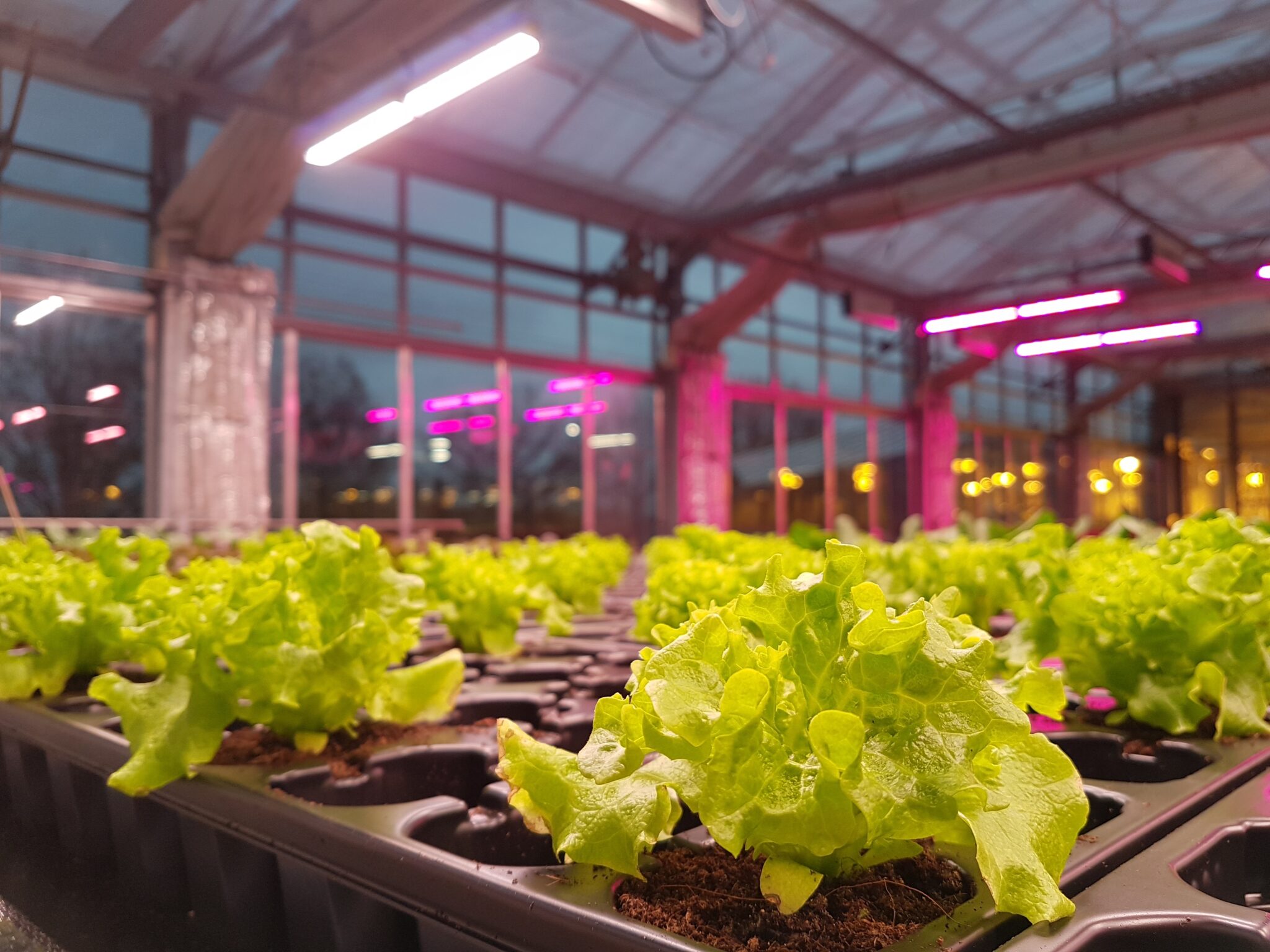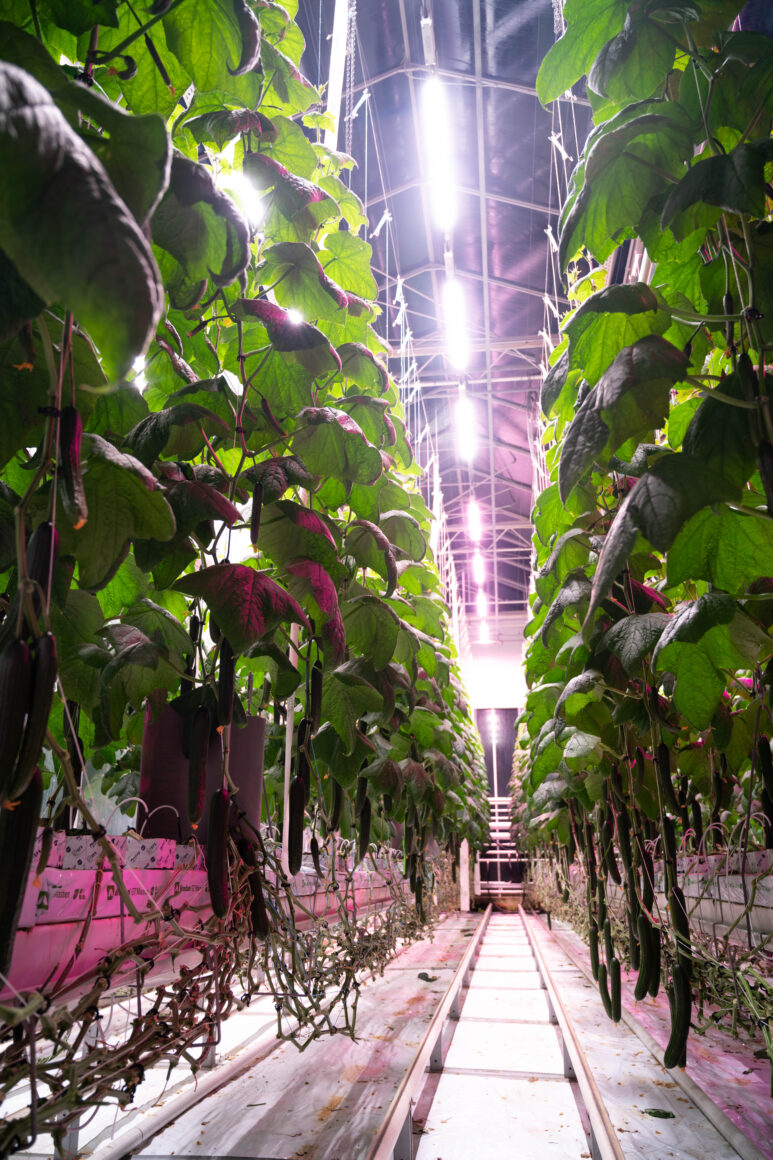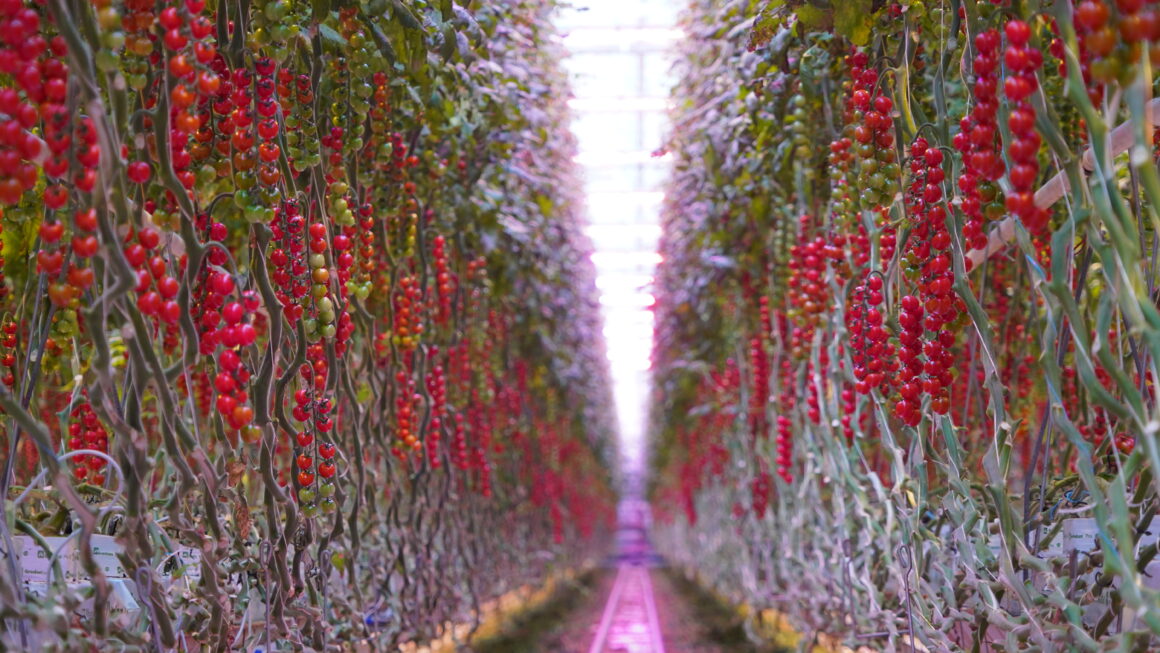
04 Dec Tricks of the Trade: Far-Red Light as a Tool for Morphological Control
Trick-or-Treat
Since the advent of light emitting diodes (LEDs), far-red (FR) light has become an intriguing tool among growers. This is especially true when it comes to crop steering—or managing and guiding a plant’s morphology. While FR is not recommended for every crop, the ability to influence plant growth, leaf size, stem length, and overall morphology has proven critical for commercial growers of vine crops–such as tomatoes, cucumbers, and peppers—as well as strawberries, lettuce, and more.
Put simply, plants in nature absorb blue, green, and red wavelengths—the most photosynthetically active radiation (PAR). Far-red, on the other hand, is more readily transmitted; As light penetrates a canopy, the plants at the top typically receive more white light, while plants on the ground or in the shade receive more far-red light. This red/far-red shift triggers a complex response that tells plants to grow and stretch beyond the shade to receive more direct sunlight.
Growers can use this understanding of far-red light to trick plants into growing and stretching as if they were in the shade. Whether growing indoors or in a greenhouse, far-red light can be a useful tool—when applied correctly—to influence the size, length, and shape of select cultivars. It is important to note that, whereas there is an abundance of academic research on far-red effects on plants, there are not yet many commercial studies or implementations of far-red at a commercial scale that clearly define exactly how it is best used by growers. Dynamic applications of LEDs with FR remain an exciting new point of horticultural research that deserves continuous study and observation.
Tomatoes
Depending on the tomato variety, far-red light can increase tomato yield by 16%. A 20-week study conducted by Signify and Wageningen University and Research affirmed that the most productive results were achieved when far-red light was applied during the photoperiod. Far-red treatments also increased sink strength, which enhances the flow of sugars to the fruit.
Peppers
Pepper is a slow-growing crop with blocky fruits. These plants need sufficient space between the fruits as they develop. When crowding occurs, the fruits bump into each other and result in misshapen or bruised produce, which is bad for business. Far-red light induces vine stretch and provides more space for peppers to develop on the vine. Whereas some new pepper cultivars are genetically more inclined to stretch, many legacy pepper crops need a percentage of FR to achieve optimal morphology.

Cucumbers
Cucumbers are a high-wire crop, which means they keep growing upwards throughout the entire season. Among growers, the preference has been to grow cucumbers with far-red. In general, FR light is used to achieve better canopy morphology by encouraging upward stretch. One example of preferred morphology can be seen in the leaves of cucumber plants, which tend to be downward cupped and droopy without FR radiation. By adding FR light, these leaves instead become flat and horizontal. This is primarily a cosmetic morphological preference rather than a purely photosynthetic advantage.
Interestingly, while far-red is a great tool for crop steering, research suggests that cucumbers can be grown well under many lights and spectra. In fact, one study under Fluence LEDs found that the highest cucumber yields were achieved with R8 (no FR in the spectrum), while R8F (some FR in the spectrum) resulted in the lowest yields. This may be because the FR increases vine and leaf mass—prioritizing the plant’s energy to the stems and leaves, which otherwise might be directed to the fruits. As more research is conducted on cucumbers, the balance between crop steering with FR and increasing harvest index should become clearer and better defined.
Strawberries
Strawberry morphology is uniquely important for a variety of reasons. For one, the overall plant canopy affects pollination success by allowing easier access to the flowers for honeybees, bumblebees, and even hand-pollination with the use of a vibrating wand. A strawberry is a compound fruit, and each individual pip must be pollinated; failing to achieve even pollination results in misshapen and undeveloped fruits. But this is just the tip of the iceberg.
Some strawberry cultivars are more prone to expansion than others, but in most cases a strawberry plant—whether Ever-Bearing or June-Bearing—is inherently compact. A compact plant canopy retains water, which leads to unfavorably humid microclimates, slower productivity, and greater susceptibility to pathogens, molds, fungi, and other pests.
Far-red light conclusively expands the strawberry canopy and improves airflow, which reduces the potential harms listed above while also improving insect pollination success and human workflow efficiency. What is more, Fluence’s greenhouse research on Sonata and Sonsation strawberry cultivars showed that FR light did not necessarily increase the total biomass of the cumulative yield, but FR played an important role in the quality of that biomass. Not only did FR treatments yield larger and higher quality fruits, but it also produced a slight uptick of BRIX (sugar content, or sweetness) while maintaining equal ratios of water content. This is an astounding discovery when it comes to the application of FR as a tool beyond crop steering.
Lettuce
Lettuce responds particularly well to FR treatments. Whereas vine crops have a relatively low harvest index—due to the plant’s production of non-harvestable vines, stems, leaves, and roots, a lettuce plant has a relatively high harvest index because the entirety of the above-ground biomass is valuable for consumption and sale. In this way, the stretching and expanding of leaves (encouraged by far-red light) is much less of a concern for growers because the leaves are the product.
However, there is still a balance that growers must consider. If a lettuce plant receives copious amounts of far red, then it goes into hyperdrive and stretches faster than its biomass production can match. In doing so, the leaves become too thin, chlorotic (pale greenish yellow in color), soft, and wimpy. Their shelf life diminishes, and they lose value or become unmarketable.
A proper balance queues the morphological response while driving photosynthesis hard enough to ensure that sugar production can keep up with the stretch. This results in thicker leaves, nice pigmentation, increased biomass, and—in total—a more marketable head of lettuce. Fluence experts have identified a sweet spot with dramatic results, finding that the right amount of far-red light and PAR can do some very good things for lettuce yields and cycle times.
Flexible Solutions
LEDs with FR can be very useful tools for commercial growers, but finding the correct balance and spectrum for each cultivar can be tricky. More than that, some LEDs with FR treatment are more trick than treat. It is important that growers have access to the best evidence and science before diving headlong into a particular spectrum. The Fluence Horticulture Services team encourages growers of any crop to speak one-on-one with a knowledgeable expert to determine the exact spectrum that will achieve their desired goals, based on individual factors such as facility type, regional DLI, energy efficiency, and more.
Working with growers and for growers, Fluence has developed the new VYPR 4 LED lighting system with far-red dual channel capability. The VYPR 4 maintains much of the familiar VYPR platform that produce and floral growers know and trust, but it offers more spectra options, better light distribution, better uniformity at any mounting height, easier installation or retrofitting, and higher light intensity with lower energy consumption. It is available in a variety of PhysioSpec™ spectra to help maximize efficiency, consistency and yield across a broad range of crops from tomatoes and strawberries to chrysanthemums and lilies. Ultimately, the VYPR 4 puts the spectrum flexibility into the hands of the grower so they can tap into the benefits of far-red light for their crops.


Dr. David Hawley
Lead Scientist
Dr. David Hawley leads the scientific research initiative at Fluence as the company’s principal scientist. His experience in controlled environment systems, horticultural lighting and cannabis metabolome naturally underpins Fluence’s mission to drive industry-leading lighting research to explore the interaction between light and life.


